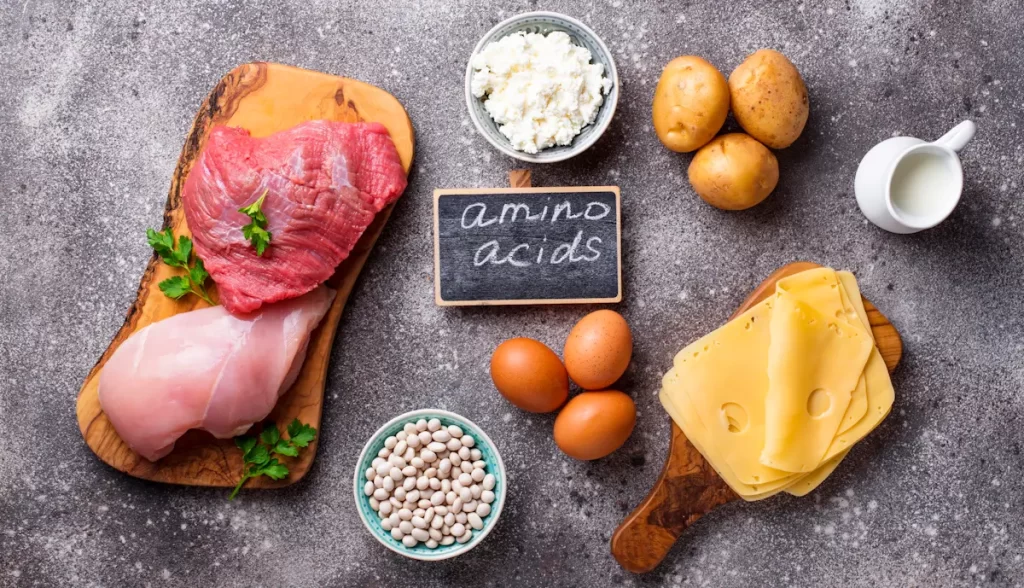Struggling to understand amino acids and why they matter? These small compounds are the building blocks of protein, which your body needs for almost everything. This blog will break down what amino acids are, their types, functions, and how they impact your health.
Thank you for reading this post, don't forget to subscribe!Keep reading—you’ll learn exactly why they’re so important!
Key Takeaways
- Amino acids are the building blocks of proteins. There are 20 types, including essential, conditional, and non-essential amino acids. The body needs nine essential amino acids from food like eggs, fish, and meat.
- They support vital functions like protein synthesis for muscle repair, tissue healing with arginine and glutamine, and nutrient absorption during digestion.
- Branched-chain amino acids (BCAAs), such as leucine, boost muscle recovery after workouts by enhancing protein synthesis. Aim for 0.144g per kilogram daily to aid exercise recovery.
- Plant-based sources like quinoa and beans provide complete proteins when combined. Supplements offer extra support for sleep, mood balance, or post-surgery healing.
- Amino acids improve immune health by activating T-cells and repairing tissues during stress or illness with nutrients like cysteine precursors for antioxidants production.
What Are Amino Acids?
Amino acids are tiny organic compounds. They combine to form proteins, which are vital for life. Each amino acid has three main parts: a carboxyl group (-COOH), an amino group (-NH2), and a unique side chain (R group).
The side chain determines the type of amino acid. There are 20 different kinds used in building proteins in your body.
These special molecules have other roles too. Some help produce neurotransmitters and hormones like thyroid hormones, while others support energy production or wound healing. Proline stands out because it has a secondary amino group, unlike others with primary ones.
Linked by peptide bonds, these alpha-amino acids create protein chains—essential for muscle growth, tissue repair, and overall health.
Types of Amino Acids
Amino acids fall into groups based on how the body uses them. Each group plays a role in keeping your body healthy and functioning well.
Essential Amino Acids
The human body cannot make certain amino acids. These are called **essential amino acids**, and they must come from food. There are nine of these: histidine, isoleucine, leucine, lysine, methionine, phenylalanine, threonine, tryptophan, and valine.
Without enough essential amino acids in your diet, problems can arise. Fatigue or weakness may set in. Growth can slow down in children. Lack of them might even lead to depression or insomnia over time.
Foods like eggs, fish, meat, soy products like tofu or edamame beans provide complete proteins with all nine essentials.
Essential amino acids evolved to depend on diets for energy efficiency.
Let’s now look into conditional amino acids and their role in the body…
Conditional Amino Acids
Essential amino acids always need to come from food, but conditional amino acids work differently. They are usually made in the body, except during special times. These include stress, illness, pregnancy, or growth periods like childhood.
Examples are arginine, cysteine, glutamine, tyrosine, glycine, proline, and serine.
For instance, glutamine becomes crucial in injury recovery or severe sickness to support healing. Arginine helps children grow and plays a major role in wound healing too. While normally not needed from food sources daily—these “semi-essential” amino acids can become vital for health under certain conditions!
Non-essential Amino Acids
Non-essential amino acids are made by the body. They don’t need to come from food sources. Examples include alanine, asparagine, aspartic acid, and glutamic acid. These amino acids play key roles in processes like protein synthesis and energy production.
Under normal conditions, the body makes enough non-essential amino acids for daily needs. For instance, glutamic acid helps with brain chemicals and nerve signals. Aspartic acid supports metabolism and energy cycles in cells.

Functions of Amino Acids in the Body
Amino acids fuel vital processes like making proteins, healing tissues, and helping your body use nutrients—learn how they power you daily!
Protein Synthesis
Protein synthesis produces proteins, vital for your body’s functions. It uses the genetic code from DNA to create amino acid sequences. These sequences are later folded into specific protein structures—primary, secondary, tertiary, or quaternary.
Ribosomes play a key role in this process by assembling the peptide bonds that link amino acids.
The body needs 20 amino acids during protein biosynthesis. This includes essential and non-essential ones like aspartic acid and glutamic acid. Each amino acid is coded using three-letter sequences (codons) in the universal genetic code—for example, GGU codes glycine.
Proteins made through this process assist with muscle repair, hemoglobin production, immune responses—even hormone creation like thyroid hormones!
Tissue Repair
Amino acids help the body heal damaged tissues. Arginine and glutamine, which are conditionally essential amino acids, play key roles in this process. They support wound healing by boosting repair and reducing harmful inflammation.
Glutamine also improves gut health by lowering pro-inflammatory cytokines and fixing intestinal walls.
Tissue repair relies on protein synthesis to rebuild structures like skin and muscle. This involves linking amino acids through peptide bonds to form new proteins. Injuries or surgeries increase the demand for these nutrients, making a proper diet crucial for recovery.
Nutrient Absorption
Nutrient absorption relies heavily on amino acids breaking down food. These building blocks help the body absorb vitamins, minerals, and other essential nutrients during digestion.
For example, glutamic acid supports gut health by aiding in nutrient uptake.
Essential amino acids play a big role too. They support protein metabolism and ensure proper energy production. A balanced diet with complete proteins from animal or plant-based sources is key for this process.
Whole grains and fiber-rich foods also promote better nutrient absorption by feeding good bacteria in your gut.

Dietary Importance of Amino Acids
Amino acids are vital for keeping your body strong and healthy. They support growth, energy production, and overall well-being.
Role in Muscle Building
Branched-chain amino acids (BCAAs) play a key role in building muscle. They help with muscle protein synthesis (MPS), which repairs and grows muscles after exercise. Out of these, leucine is the most important for triggering MPS.
Hard training increases your body’s need for protein. Experts suggest 1.4 to 2 grams of protein per kilogram daily if you work out intensely. For BCAAs, aim for 0.144 grams per kilogram each day to support muscle growth and recovery efficiently.
Impact on Metabolism
Amino acids regulate metabolism by influencing pathways like mTORC1 and GCN2. These pathways sense amino acid availability and help the body manage energy production. Glucogenic amino acids, for example, create glucose during fasting or intense exercise.
This process keeps blood sugar stable and fuels essential functions.
Restricting sulfur-containing amino acids (SCAAs) can improve health as people age. Studies suggest it reduces risks linked to diseases like diabetes or heart issues. BCAAs also support protein metabolism, helping with energy balance and muscle recovery after workouts.
This makes them vital for both active lifestyles and long-term wellness goals.
Importance for Immune Function
Strong immune health depends on amino acids. They help activate key immune cells like T-cells, B-cells, and macrophages. Without enough dietary protein or amino acids, the body struggles to fight infections.
This can leave you more vulnerable to illnesses.
Certain types boost immunity even more. For example, arginine supports wound healing and fights inflammation. Glutamine helps repair tissues and fuels immune cells during stress or illness.
Cysteine precursors help create antioxidants that defend against cell damage. Supplements with these can improve immunity in malnourished people too!

Sources of Amino Acids
Amino acids come from the foods you eat or supplements you take. Different protein sources provide varying amounts and types of these building blocks.
Animal-Based Proteins
Animal-based proteins are rich sources of essential amino acids. Foods like beef, poultry, eggs, and dairy provide all nine essential amino acids your body needs. These complete proteins support protein synthesis and muscle recovery.
Fish is another excellent choice, offering high-quality protein with additional omega-3 fatty acids for heart health.
Including animal-based proteins in the diet can improve metabolism and aid tissue repair. For example, 3 ounces of chicken breast contains about 26 grams of protein—perfect for rebuilding tissues after exercise.
Eggs are versatile too; one large egg has around 6 grams of easily digestible protein. With these options available, plant-based alternatives also play a crucial role….
Plant-Based Proteins
Plant-based proteins offer essential amino acids needed for the body. They come from sources like beans, lentils, quinoa, nuts, and seeds. Together, these provide complete protein nutrition.
Cereals and legumes are also excellent options for boosting protein intake. About 57% of the world’s dietary protein comes from plants.
Combining different plant foods balances amino acid levels. For example, pairing rice with beans ensures a better mix of essential nutrients. These proteins support muscle recovery, energy production, and immune health without relying on animal sources.
Supplements
Supplements can provide amino acids when natural sources are not enough. They support sleep, mood, and athletic performance. Tryptophan supplements, at 0.143 grams a day, may improve mood and reduce anxiety.
Branched-chain amino acids (BCAAs) help with muscle soreness and recovery, requiring 0.039–0.087 grams per kilogram of body weight.
After surgery, these supplements may lower complications and boost healing. Athletes often use them for energy production and better muscle recovery during workouts. L-carnitine is another option that supports fat metabolism while aiding exercise performance.

Amino Acids and Health
Amino acids play key roles in exercise recovery, mood balance, and faster healing—read on to learn how they support overall well-being.
Benefits for Exercise and Recovery
Branched-chain amino acids (BCAAs) play a big role in muscle recovery. Consuming 0.144g per kilogram daily helps repair muscles faster. This is especially useful after intense workouts or sports activities.
These amino acids, like leucine, also boost protein synthesis in the body, promoting stronger and healthier muscles.
Supplementing with BCAAs reduces exercise fatigue and improves athletic performance. They provide energy during long workouts by supporting protein metabolism and energy production.
Taking proteins or supplements before, during, or after a workout enhances recovery time too—making it easier to bounce back for your next session.
Contribution to Mood Stability
Tryptophan helps your brain produce serotonin, a key chemical for mood improvement. Low levels of serotonin can lead to depression or increased aggression. A diet rich in complete proteins ensures enough tryptophan for healthy serotonin production.
Tyrosine supports the creation of dopamine and norepinephrine, which help manage stress. These neurotransmitters improve focus during challenging times. Foods like eggs, fish, and soy provide these amino acids in abundance.
Next—support for wound healing…
Support for Wound Healing
Arginine and glutamine play key roles in healing wounds. Arginine boosts collagen production by increasing hydroxyproline levels, which strengthens skin tissue. Glutamine improves nitrogen balance, aiding recovery during injury or surgery.
Studies show arginine and glutamine reduce inflammation markers like IL-6 and TNF. These amino acids support every stage of wound repair. Supplements containing these nutrients can speed up the process and improve outcomes for patients.
Conclusion
Amino acids are small but mighty. They help build proteins, repair tissues, and even boost your energy. Getting enough from food like meat, beans, or supplements is key for good health.
These building blocks support muscles, metabolism, and the immune system daily. Eating a balanced diet makes sure your body gets what it needs to thrive!
